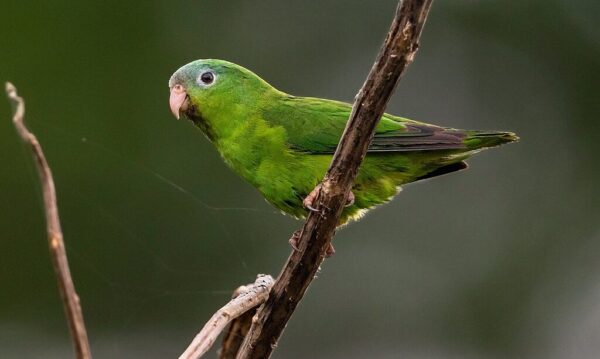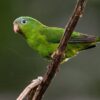Amazonian Parrotlet
Also known as:
Manu Parrotlet
Also known as:
Manu Parrotlet
DID YOU KNOW?
The Amazonian Parrotlet was first discovered in 1991.

Nannopsittaca

dachilleae
Size:
12 cm (4.68in)
Weight:
38-46 g.
Subspecies including nominate:
one
Colour Adult:
Both adults mainly yellow/green in colour; light blue lores, forehead and forecrown; yellow/green cheeks and chin; olive wash to mantle and lesser wing coverts. Beak pale pink. Eye brown.
Colour Juvenile:
Not recorded.
Call:
Calls are described as high-pitched and piping, sounding very like domestic fowl chicks.
Content Sources:
CITES
BirdLife International
Cornell Lab of Ornithology/Birds of the World
A Guide to Parrots of the World, Juniper and Parr, 1998.
Parrots of the World, Forshaw, 2006. 2010 edition
Captive Status:
Not found in aviculture.
Longevity:
—
Housing:
—
Diet:
—
Enrichment:
—
Nest Box Size:
—
Clutch Size:
Not recorded.
Fledging Age:
—
Hatch Weight:
—
Peak Weight:
—
Weaning Weight:
—
World Population:
2500-10,000 mature individuals. Descriptions range from very common to patchily distributed and very uncommon.
IUCN Red List Status:
Least Concern
CITES Listing:
Appendix II
Threat Summary:
Not globally threatened. Common to abundant at some localities and very uncommon in others. This species’ habitat has been subjected to oil exploration, mining and some logging.
Range:
Western Amazon River basin, where recorded in E Peru from Iquitos district, Loreto, drainages of Rio Ucayali, Ucayali and Rio Manu, Madre de Dios, and along Rio Heath, La Paz, NW Bolivia.
Habitat:
Found up to 300 m (984 ft) in lowland forest near rivers and streams, Calocophyllum and Cecropia sp. treed areas, and bamboo groves.
Wild Diet:
Feeds on fruits and also Cecropia catkins, fruits or seeds of an arboreal epiphytic cactus Rhipsalis, Vernonia and Guadua bamboo seeds, and ripe fruits of Coussapoa vine.
Ecology and Behaviour:
Social and active; forms flocks of up to 12 individuals. Frequents mineral-rich river banks with other parrots.
Clutch and Egg Size:
Not recorded.
Breeding Season:
Possibly July-September; one nest cavity recorded in epiphyte clump.
Related Links:
—

